
Marie Hélène Pietraru, doctorante du NIMBE/LCMCE encadrée par T. Cantat et E. Nicolas, a obtenu le prix du Jury de la meilleure communication orale au Congrès GECOM-CONCOORD, réunissant communauté française de chimie de coordination, à Fournols du 22 au 26 mai 2023.
Ce Prix lui a été décerné pour sa communication intitulée : “Catalytic carbonylation of acrylic acid to succinic anhydride“, concernant une partie de ses travaux de thèse, et qui ont fait l’objet d’un brevet CEA et d'une publication (en cours de referee).
Félicitations !
Marie-Hélène Pietraru, Nicolas Lentz, Louise Ponsard, Emmanuel Nicolas, Thibault Cantat,
Université Paris-Saclay, CEA, CNRS, NIMBE, 91191, Gif-sur-Yvette, France
Abstract: Nowadays, the share of plastics reaches 90 % of the production of petrochemicals. To reduce our dependence on fossil feedstock for the synthesis of polymers, renewable starting materials could be used instead. In this context, we are targeting the formation of a monomer, succinic anhydride, from bio-based starting materials. The current industrial production of succinic anhydride relies on the oxidation and hydrogenation of petrosourced n-butane; another route consists in promoting the carbonylation of β-propiolactone, also a petrochemical.1 As an alternative, we developed the carbonylation of acrylic acid, an isomer of β-propiolactone, which is not only a common platform chemical, but has also the potential of being biosourced.
Early studies on the carbonylation of acrylic acid highlighted the difficulty of performing a selective, efficient and direct carbonylation reaction on acrylic acid.3 Yet, by designing a selective low-valent cobalt complex supported by phosphine ligands, the production of succinic anhydride from acrylic acid was unlocked, thanks to mild reaction conditions (90 °C, 16 bar).4 Screening of several reactio n parameters such as gas phase pressure and composition, ligands and temperature, enabled us
to propose some mechanistic hypotheses to rationalize the trends observed during this challenging carbonylative ring-closure.



